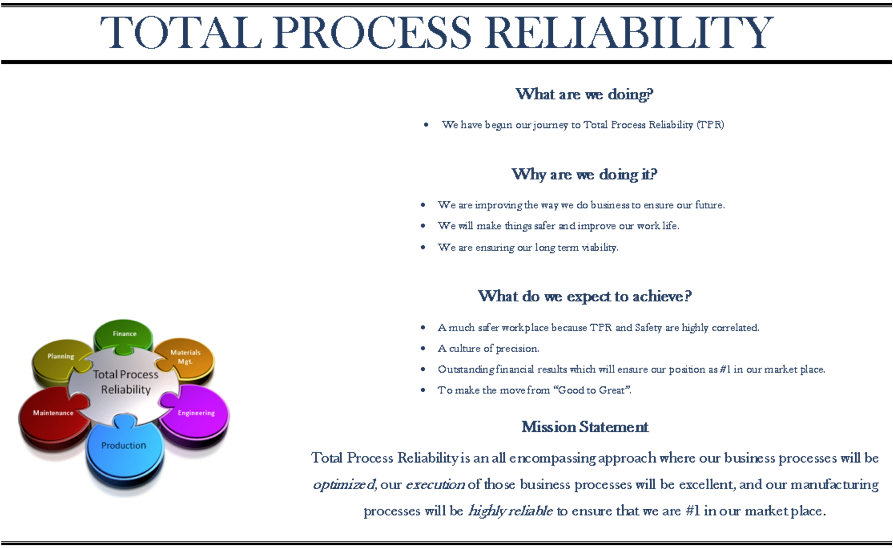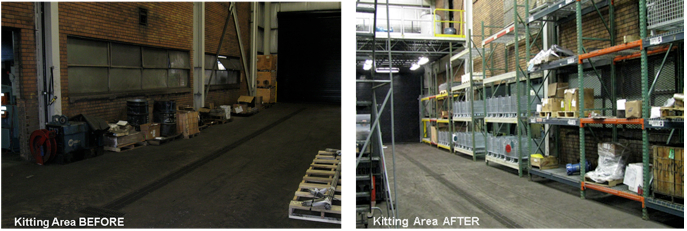Coke-Producer-Addresses-Financial-Challenges-with-Reliability-Excellence-321
The Situation:
A metallurgical coke producer, co-located with a large steel production facility in the middle of Detroit, Michigan, was struggling with reactive maintenance practices which were negatively impacting financial results for the company and creating a difficult work environment for its personnel.
The Challenges:
After a candid review of current business practices and operational processes, the leadership team identified a pattern of suboptimal behaviors and results that warranted a significant organizational change in order to stay competitive in a fluctuating marketplace. Items identified as areas of opportunity included:
- Poor safety performance
- Inadequate production results
- High maintenance costs
- Poor efficiency
- Repeat failures due to poor reliability
- Breakdown calls in the middle of the night
- A culture that rewarded reactive employee behavior
The leadership team at the site partnered with Life Cycle Engineering and embarked on a journey of Reliability Excellence®. The team had a vision that an organizational transformation could be achieved through establishing a solid foundation of reliability principles that would guide operational decision making. As a former maintenance leader, the plant manager knew that life in a reactive plant was extremely hard on equipment and, more importantly, detrimental to employees.
The site set out on a mission to establish an efficient, high-performance plant where employee quality of life was high and financial results stable.
The Approach:
Implementation began by identifying a baseline of current business practices to compare against reliability best practices. Performance gaps and areas of improvement were identified through a comprehensive assessment conducted by Life Cycle Engineering. The assessment process included employee interviews, onsite observations, data acquisition and analysis. The results confirmed that the site’s manufacturing practices were extremely reactive and were hampered by significant materials management issues.
The assessment was conducted at a time when the steel-making industry was experiencing deep cutbacks; consequently, the site’s production was curtailed significantly. Without the volume to support improvement efforts in the facility, the Reliability Excellence® implementation was deferred until business conditions returned to a healthier state. Nonetheless, the leadership team continued to work proactively to create a workplace culture that encouraged ownership, execution and excellence in the workplace. Additionally, the site was able to secure funding to hire its first Reliability Engineer. The team continued to lay the foundation for the reliability initiative by organizational restructuring and redirection of hourly employees. When economic conditions improved, the site began a comprehensive Reliability Excellence® implementation.
Three critical actions were taken in the early stage of implementation: leadership alignment, project management and infrastructure reengineering. The leadership alignment efforts resulted in the establishment and communication of a common vision and mission. The initiative was named “Total Process Reliability.”
 The team then focused on finding the right person to manage the project. A well-respected member of the operations group was chosen for project oversight. The last major action for the project kickoff was to establish teams to reengineer the infrastructure. This included a review of existing practices, a redesign of critical business processes and implementation actions. The five teams were based on the foundational elements of Total Process Reliability.
The team then focused on finding the right person to manage the project. A well-respected member of the operations group was chosen for project oversight. The last major action for the project kickoff was to establish teams to reengineer the infrastructure. This included a review of existing practices, a redesign of critical business processes and implementation actions. The five teams were based on the foundational elements of Total Process Reliability.
- Work Management – These processes were designed to control how the site would manage the execution of maintenance resources and the coordination of operations activities to ensure that repairs were completed in accordance with industry best practices.
- Operator Care – This work stream helped focus operational groups on systems that:
• Identify losses in the coke battery and other productions streams
• Equip operators with more substantial support with procedures and checklists
• Engage operators in the cleaning, adjusting and detection of issues in the equipment used daily - Maximo Implementation – The site was converting from a prior CMMS to the Maximo system during the course of the implementation and this team was tasked with working with corporate IT and site personnel to create a highly effective Enterprise Asset Management System.
- Materials Management – The focus of this team was on the processes involved in material storage, requisitioning, kitting of materials, accuracy of inventories and other MRO issues. It was also tasked with consolidating and relocating several different materials storage areas.
- Reliability Engineering – Being a new function to the organization, this group focused on the creation of Reliability Engineering processes, the development and execution of its Preventive Maintenance (PM) and Predictive (PdM) programs and strategic asset management programs such as hierarchy development and criticality analysis.
The Results:
In the first 14 months of the implementation of Total Process Reliability the site experienced dramatic improvements in these areas:
Materials Management – The team worked diligently to raise awareness and education of employees on how effective materials management can dramatically improve maintenance and operations functionality at the coke battery. The site implemented a kitting program for delivery of parts required for planned maintenance jobs, which decreased job completion times. The consolidation of several material storage areas resulted in better inventory control of stocked parts and a reduction in the amount of time spent looking for parts.

Plant Performance – One of the most important metrics for success in a coke battery is the delay rate. Delay rate measures how much time is lost during production – pushing coke out of the oven. The plant reduced its delay rate by 40% over the prior year.
Partnerships – This has been a key area of improvement for the plant because it has a significant impact on plant operations. Silos were broken down and the different functional areas worked together to execute newly designed processes. The plant manager observed that the partnership agreements “have really taken away much of the head-banging that different departments used to engage in.”
Metrics – By setting up a key set of metrics to measure the performance of the plant and the implementation success of Total Process Reliability, the plant leadership team has the right information to manage the plant efficiently. It allows leadership to effectively monitor progress in critical improvement areas.
Safety – Injury rates have declined after the reliabliity implementation. Only one year after implementation, the site reported no recorded injuries.
Written Processes – Defining business processes removed much of the variability from shift to shift and department to department. Performance improved by setting clear expectations for job roles and responsibilities.
Conclusion:
While the plant is still working through the challenges of adopting and executing the new processes, it has made significant improvements over prior years. The leaders are committed to continuing the reliability journey to achieve organizational production goals while improving the lives of employees. Employees are proud to be a part of a team focused on continuous improvement that is in constant pursuit of achieving world-class performance.
© 2014 Life Cycle Engineering, Inc.
For More Information
843.744.7110 | info@LCE.com















